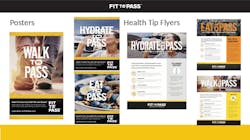In response to the COVID-19 national health emergency, the Federal Motor Carrier Safety Administration (FMCSA) issued a waiver granting an extension for re-certifications for commercial driver’s license (CDL) holders through Sept. 30. Come Oct. 1, that could mean an influx of commercial truck drivers up for recertification. The main concern, however, is whether drivers will be able to pass these exams.
Commercial truck drivers are typically at a higher risk for high blood pressure, high cholesterol, obesity, type 2 diabetes, heart conditions and more due to the sedentary nature of the job and unhealthy eating habits on the road. Those health conditions can make passing the Department of Transportation (DOT) re-certification exam quite challenging for many truckers.
Long-time truck driver health and wellness advocate Bob Perry, The Trucker Trainer, who also helped develop Espyr’s Fit to Pass program, explained the industry loses thousands of drivers every month because they are unable to maintain their health parameters and pass their DOT re-certification exam. Espyr is a behavioral health and wellness company, and Fit to Pass is a year-round coaching program designed to improve the health of professional drivers and help drivers maintain their CDLs.
During a July 14 Truckload Academy webinar, Perry joined Jeff Joo, Espyr’s vice president of sales, and Doug Schrier, Transflo’s vice president of product and innovation, to discuss “DOT Re-Certifications: Improving & Sustaining Driver Wellness.”
Earlier this year, Transflo announced an integration with Espyr’s Fit to Pass program that allows users to access online tools via the Transflo Mobile+ app. The program aims to keep drivers on the road; help fleets retain experienced, skilled drivers; help fleets save on hiring costs and training new drivers; reduce driver sick days; and increase overall productivity.
Joo pointed out that CDL driver turnover rates tend to exceed 95%, a lot of which is voluntary, health-related turnover. He also noted that hiring commercial truck drivers is one of the most expensive hiring costs in the U.S., coming in at around $8,200 per driver. In addition, before any knowledge of COVID-19, the projected driver shortage for this year was roughly 150,000 drivers.
“There has been a moratorium on the DOT physical through Sept. 30, which also means there is going to be a run-on as a lead up to Oct. 1,” Joo explained. “The hope is these drivers will be prepared for that, and we all know that many of them won’t be. Not having enough adequate facilities to go to get healthy meals and to exercise as we’re dealing with this pandemic really puts an emphasis on how can we prepare these drivers for these physical exams, and what can we do to make certain that they’re in the best possible shape and in the best possible position to be successful for that exam.”
Fit to Pass, which is accessible on its own and from within the Transflo app, offers health tips, chats with a coach, and multiple communication modes for drivers. It also gives drivers direct access to a coach at any point in time.
“The importance of that is we know the driver lifestyle,” said Joo. “There are times when their downtime is the best time they can call, and it could be three o’clock in the morning. We want to make sure those drivers have access and have the ability to get questions answered and the assistance they need in the time they have available.”
While Fit to Pass is designed to help improve and maintain year-round driver health, including personal hygiene protection, the program intensifies 90 days prior to a driver’s DOT re-certification exam. The program also offers customized health-related content, including exercises, videos, and nutritional guidelines for restaurants at truck stops.
“When they go to [CDL] school, we teach them how to backup and stay in between the lines, but we teach them nothing about how to stay healthy on the road,” he stressed. “If you’re going to be safe, you’ve got to be well. Their main challenges are really managing their blood pressure and their sugar levels.”
“We have to help them make simple, small changes,” Perry added. “When you are taking in 4,500 calories a day, it’s not hard to reduce 3,000 to 4,000 calories a week, and before you know it, it’s 10 pounds; 10 pounds has been our benchmark. If we get a driver down 10 pounds, they see results.”
Perry also emphasized the importance of personal hygiene protection when it comes to driver health. For drivers who are pre-diabetic, at the end of the day, it is especially important for them to remove their socks and wipe their feet after they take off their shoes if they can’t access a shower, Perry said.
“They need to take those dirty socks off from sweating all day long,” he explained. “Drivers should make sure they have wipes available to wipe their bodies down, because in this time of year and in the heat when they are sweaty and not clean, it’s a time they can create bacteria and infection, and before you know it, they’ve got a nasty boil.”
Perry added that while it is important for drivers to conduct pre-checks of their vehicles, they should also do pre-checks for themselves. He stressed the importance of drivers ensuring that their in-cab refrigerators are stocked with the right kind of energy, so when the truck’s wheels are ready to start rolling, so are the drivers’ bodies.





